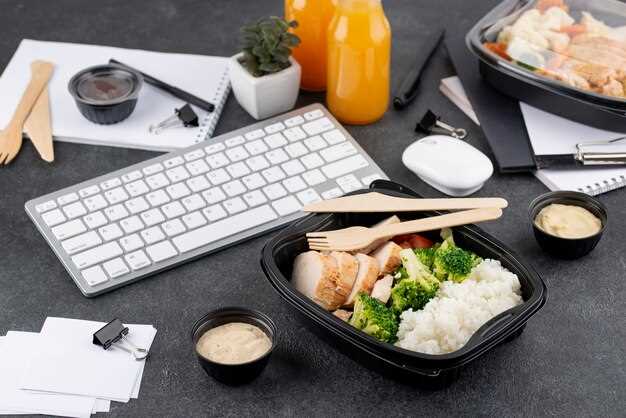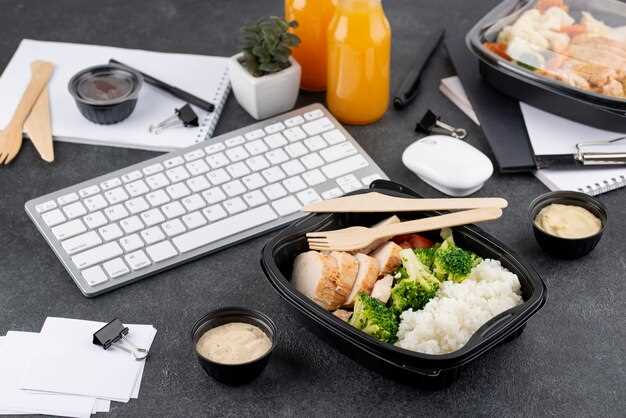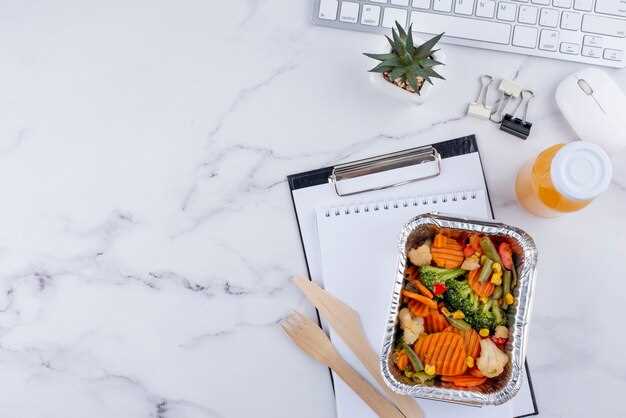Creating a Balanced Lunch for Optimal Productivity

Prioritize protein, healthy fats, and complex carbohydrates to fuel your afternoon productivity. Incorporate lean meats like chicken or turkey, plant-based proteins such as lentils and beans, and opt for whole grains like quinoa or brown rice. This combination stabilizes blood sugar levels, providing sustained energy throughout the day.
Add colorful vegetables to your plate. Leafy greens, bell peppers, and carrots not only enhance the nutrient profile but also boost cognitive function. Aim for a variety of textures and flavors to keep meals interesting and appealing. A well-rounded plate supports concentration, making tasks feel less daunting.
Don’t forget to include hydration. Water is crucial for mental clarity and overall health. Pairing your meal with a refreshing herbal tea or sparkling water can enhance the experience. Adequate hydration prepares both body and mind to tackle tasks efficiently.
Consider meal prepping to optimize your lunch choices. Preparing meals in advance ensures that you have balanced options ready, reducing the temptation of unhealthy choices. This strategy saves time, allowing more moments for creativity and focus once the workday resumes.
Understanding Nutritional Needs for Office Workers

Office workers should consume a balanced mix of macronutrients to sustain energy levels throughout the day. Aim for a combination of complex carbohydrates, lean proteins, and healthy fats. Whole grains, such as brown rice or quinoa, provide long-lasting energy, while proteins like chicken, fish, or legumes support mental focus and mood stability.
Incorporate fiber-rich fruits and vegetables into meals to enhance digestion and improve concentration. Options like berries, leafy greens, and bell peppers not only provide essential vitamins and antioxidants but also help maintain hydration. Consider snacking on nuts or seeds between meals to boost satiety and provide a steady energy source.
Monitor hydration levels by drinking water regularly. Dehydration can lead to fatigue and decreased cognitive performance. Aim for at least eight glasses of water daily, adjusting based on activity levels. Herbal teas or infused water with fruits can make hydration more enjoyable.
Limit processed foods high in sugars and unhealthy fats. These can cause energy crashes and hinder overall productivity. Opt for whole, unprocessed foods whenever possible, as they supply more nutrients and enhance well-being.
Pay attention to portion sizes to avoid post-lunch sluggishness. Eating smaller, balanced meals throughout the day can help maintain energy without overloading the digestive system. Consider meal prepping to ensure healthy options are readily available during busy workdays.
Key Components of a Balanced Lunch

A balanced lunch requires a thoughtful combination of macronutrients and micronutrients. Prioritize incorporating proteins, healthy fats, complex carbohydrates, and plenty of vegetables. This combination fuels your body and keeps you focused throughout the afternoon.
Macronutrient Breakdown
Select high-quality proteins such as grilled chicken, beans, or tofu. Aim for at least 20-30 grams of protein per meal to support muscle repair and satiety. Healthy fats from avocados, nuts, or olive oil should also play a role, providing energy and aiding digestion. Include complex carbohydrates like whole grains or sweet potatoes, which release energy slowly, maintaining stable blood sugar levels.
Micronutrient Inclusion
Load your plate with a variety of vegetables. These add essential vitamins, minerals, and fiber. A colorful mix, including leafy greens, bell peppers, and carrots, enhances nutrient intake while keeping your lunch appealing. Consider adding fruits for a natural sweetness and extra vitamins.
| Component | Examples |
|---|---|
| Protein | Grilled chicken, beans, tofu |
| Healthy Fats | Avocado, nuts, olive oil |
| Complex Carbohydrates | Quinoa, brown rice, sweet potatoes |
| Vegetables | Spinach, carrots, bell peppers |
| Fruits | Apples, berries, oranges |
By balancing these components, you’ll enhance your productivity and sustain energy levels, making lunchtime both nourishing and restorative.
Choosing Whole Grains for Sustained Energy

Opt for whole grains to enhance your lunch menu. Whole grains provide lasting energy due to their high fiber content, which slows digestion and helps maintain stable blood sugar levels. This balance not only fuels productivity but also curbs mid-afternoon cravings.
Types of Whole Grains to Include
Select from a variety of whole grains to keep your meals interesting. Consider incorporating:
| Whole Grain | Benefits |
|---|---|
| Quinoa | High in protein and contains all essential amino acids. |
| Brown Rice | Rich in magnesium and promotes heart health. |
| Whole Wheat Bread | Great source of B vitamins, important for energy metabolism. |
| Oats | Supports digestion and keeps you full for longer. |
| Barley | Contains beta-glucans that help lower cholesterol levels. |
How to Incorporate Whole Grains
Combine whole grains with lean proteins and vegetables for a balanced lunch. Create a quinoa salad topped with beans and plenty of veggies, or enjoy a bowl of brown rice with grilled chicken and steamed broccoli. Snack options can include whole grain crackers with hummus. Switching to whole grains elevates not just energy levels but also boosts overall health. Consistent inclusion will lead to noticeable improvements in focus and productivity throughout the day.
Incorporating Lean Proteins into Your Lunch

Lean proteins boost energy and enhance focus during the day. Opt for options with low fat content, which help maintain steady blood sugar levels and promote sustained productivity. Here are some excellent choices:
- Grilled Chicken Breast: High in protein and low in fat, it keeps you full longer. Slice it for salads or wraps.
- Turkey: Lean turkey slices or ground turkey can replace red meat in sandwiches and bowls for a healthier alternative.
- Tuna: Packed with omega-3 fatty acids, canned tuna is easy to mix with greens or whole grain crackers.
- Tofu: A great plant-based option, tofu absorbs flavors well and adds protein to stir-fries or salads.
- Legumes: Beans and lentils are rich in protein and fiber. They work well in soups, salads, or as side dishes.
Simple Recipes to Try
- Grilled Chicken Salad: Combine grilled chicken, mixed greens, cherry tomatoes, and a light vinaigrette.
- Turkey Wrap: Use a whole grain tortilla, fill it with turkey, spinach, avocado, and a sprinkle of feta.
- Tuna Salad: Mix canned tuna with diced celery, Greek yogurt, and mustard. Serve on whole grain bread or lettuce wraps.
Integrating these lean proteins not only enhances your lunch but also promotes a productive afternoon. Keep your meals diverse by alternating between meat, poultry, fish, and plant-based options. Enjoy the benefits of better focus and energy throughout your day!
The Role of Healthy Fats in Mental Clarity
Incorporating healthy fats into your lunch can significantly boost mental clarity and focus. Foods rich in omega-3 fatty acids, such as avocados, nuts, and fatty fish, support brain health by enhancing cognitive functions. For instance, walnuts and flaxseeds provide high levels of alpha-linolenic acid (ALA), which is linked to improved memory and concentration.
Maintaining steady energy levels throughout the day is essential for productivity. Healthy fats digest slowly, preventing energy spikes and crashes. Including a handful of almonds or a drizzle of olive oil on your salad delivers sustained energy, allowing you to keep your mind sharp longer.
Another benefit of healthy fats involves their role in reducing inflammation. Chronic inflammation can impair cognitive function, leading to poor concentration. Incorporating sources like salmon or chia seeds can help combat this issue, enhancing both mental agility and mood.
Don’t forget about the brain’s structural needs. About 60% of the brain is composed of fat, emphasizing the importance of quality sources. Using nut butters on whole-grain toast or enjoying a guacamole dip can provide your brain with the necessary nutrients to function optimally.
Lastly, consider combining healthy fats with other food groups. Pairing them with complex carbohydrates, such as quinoa or sweet potatoes, can create balanced meals that not only satisfy your hunger but also maximize cognitive performance. A well-rounded lunch incorporating healthy fats paves the way for improved focus and productivity throughout the day.
Selecting Colorful Fruits and Vegetables
Incorporate a variety of colorful fruits and vegetables into your lunch to boost both nutrition and appeal. Each color represents different nutrients, enhancing your overall diet.
Benefits of Colorful Choices
- Red: Tomatoes, red bell peppers, and strawberries are rich in lycopene and anthocyanins, supporting heart health and reducing inflammation.
- Orange: Carrots and sweet potatoes provide beta-carotene, promoting good vision and immune function.
- Yellow: Pineapples and corn supply vitamins A and C, aiding digestion and providing antioxidants.
- Green: Broccoli, spinach, and avocados are loaded with vitamins K, C, and E, bolstering bone health and skin radiance.
- Blue/Purple: Blueberries and eggplants contain flavonoids that can enhance brain function and reduce heart disease risk.
Practical Tips for Selection
- Shop at local farmers’ markets for fresh, seasonal produce.
- Choose organic options when possible to minimize pesticide exposure.
- Mix raw and cooked vegetables for different textures and flavors.
- Try to fill half your plate with fruits and vegetables to ensure proper portioning.
- Experiment with colorful smoothies, salads, or stir-fries to keep meals exciting.
Brightening your plate with a variety of colors not only enhances the visual appeal but also enriches your nutrition, leading to improved productivity throughout the day.
Quick Meal Prep Ideas for Busy Days
Prioritize prepping a batch of quinoa on Sundays. Use it as a base for salads, bowls, or as a side throughout the week. Combine cooked quinoa with black beans, corn, diced peppers, and a squeeze of lime for a refreshing salad that stores well.
Overnight Oats for Breakfast
Create easy overnight oats using rolled oats, yogurt, and your choice of milk. Add chia seeds, honey, and seasonal fruits. Let them soak overnight in jars, so you have a nutritious breakfast ready to go. Mix flavors like banana and peanut butter or apple and cinnamon to keep it interesting.
Veggie and Protein Packs
Cut vegetables like bell peppers, carrots, and cucumbers and package them with hummus or guacamole for quick snacks. Pair with hard-boiled eggs or sliced turkey for a protein boost. This combination helps maintain energy levels and curbs cravings.
Prepare stir-fry kits by chopping your favorite vegetables and portioning them into bags. Include proteins like chicken, tofu, or tempeh. When it’s time to eat, just stir-fry with a splash of soy sauce and serve over rice or noodles.
Freeze smoothie packs with fruits, spinach, and yogurt. Just blend with your choice of liquid in the morning for a refreshing drink that fuels your day.
Cook a large batch of whole-grain pasta, toss with olive oil, garlic, and roasted vegetables. Divide into servings for lunch or dinner, and top with protein of choice for a filling meal.
Portion Control: Balancing Macronutrients
Divide your plate into sections to ensure a harmonious balance of macronutrients. Aim for half of your plate filled with vegetables and fruits, a quarter with lean proteins, and a quarter with whole grains or healthy fats. This method helps maintain stable energy levels throughout the day.
Understanding Macronutrient Ratios
For optimal productivity, consider the macronutrient ratios. A common recommendation is to aim for 40% carbohydrates, 30% protein, and 30% fats. Adjust these ratios based on your activity level and personal preferences. For example, if you engage in regular physical activity, increasing carbohydrate intake slightly can provide the necessary fuel.
Practical Tips for Portion Control
Use measuring tools or your hand as a guide. For instance, a serving of protein should resemble the size of your palm, while carbohydrates can fit within a cupped hand. Fill your plate with colorful vegetables, as these boost nutrients while keeping calories in check. Pack snacks like nuts or yogurt in small containers to avoid overindulgence and maintain portion control. This simple approach allows for mindful eating and sustains energy levels for improved focus and productivity.
Hydration: The Overlooked Component of Lunch
Drink at least 16 ounces (about 500 ml) of water with your lunch. This simple act can enhance focus and support digestion. Water facilitates nutrient absorption and helps maintain energy levels, preventing that post-lunch slump. If drinking plain water feels dull, add slices of lemon, cucumber, or berries for flavor.
Benefits of Staying Hydrated
Proper hydration improves cognitive function. Studies show that even mild dehydration can lead to fatigue and decreased concentration. Keeping a water bottle on your desk serves as a reminder to drink throughout the day, especially during lunchtime.
Hydration Tips for Lunch
Incorporate hydrating foods into your lunch. Foods like cucumbers, tomatoes, and watermelon have high water content. Pairing these foods with your main meal can boost overall hydration. Additionally, herbal teas or infused water can be refreshing alternatives. Aim for a variety of options to keep hydration enjoyable.
Adapting Lunches for Special Dietary Needs
Prioritize whole foods such as lean proteins, fruits, vegetables, and whole grains for nutritious lunches. For gluten-free options, select quinoa, brown rice, or gluten-free breads. Incorporate beans or lentils as a protein source, enhancing fiber intake without gluten.
If you’re catering to a vegan diet, focus on legumes, nuts, seeds, and plant-based proteins like tofu or tempeh. Mix a variety of colorful vegetables in salads or grain bowls to maximize nutrient intake. Use avocado or tahini for healthy fats and added flavor.
For those with dairy intolerance, consider alternatives like almond milk yogurt or cashew cheese. A Mediterranean-style lunch with hummus, cucumbers, and whole grain pitas can be both fulfilling and dairy-free.
When cooking for someone with nut allergies, substitute seeds such as sunflower or pumpkin. Opt for seed butters instead of nut butters to avoid cross-contamination while maintaining protein-rich options.
Reducing sugar intake can be crucial for some individuals. Choose natural sweeteners like fresh fruits or limit desserts to dark chocolate or energy bites made with dates and oats. Encourage whole fruit snacks to satisfy sweet cravings without added sugars.
For protein-heavy meals, incorporate grilled chicken, fish, or plant-based proteins. Pair with leafy greens or steamed vegetables to maintain balance. Use herbs and spices to enhance flavor without relying on high-sodium sauces.
Adapting lunch menus for specific dietary needs enhances satisfaction and productivity. A customized approach ensures everyone enjoys a tasty, nourishing meal that supports their health goals.
Simple Recipes for Balanced Lunch Boxes
Prepare a quinoa salad with cherry tomatoes, cucumber, and feta cheese. Cook 1 cup of quinoa, cool it, and mix in diced vegetables. Drizzle with olive oil and lemon juice for flavor. This dish provides protein and fiber.
Veggie Wrap
Use whole grain tortillas filled with hummus, spinach, grated carrots, and bell peppers. Roll tightly and slice into pinwheels. Pack these with a side of grapes or apple slices for a sweet touch.
Chickpea Salad
Combine canned chickpeas, diced red onion, parsley, and a squeeze of lime juice. This salad is rich in protein and adds a hearty option to your lunch box. Serve it with whole grain pita chips for crunch.
- For a protein boost, add grilled chicken or tofu to salads.
- Incorporate nuts or seeds for healthy fats and texture.
- Include a serving of yogurt or a small cheese portion for dairy options.
Mix and match these recipes to create diverse lunch boxes throughout the week while keeping meals balanced and nourishing.
Video:
MEAL PREP tips & tricks YOU NEED TO KNOW (beginner friendly + how to stop making boring food)
MEAL PREP tips & tricks YOU NEED TO KNOW (beginner friendly + how to stop making boring food) by Kayla Nelson 228,634 views 2 years ago 18 minutes
Q&A:
What are the key components of a balanced lunch for enhancing productivity?
A balanced lunch typically includes a combination of macronutrients: carbohydrates, proteins, and healthy fats. For example, whole grains like brown rice or quinoa can provide sustained energy, while lean proteins such as chicken or legumes help in muscle repair and fullness. Incorporating healthy fats, like avocados or nuts, supports brain function. It’s also beneficial to add plenty of fruits and vegetables for vitamins and minerals, which enhance cognitive function and overall well-being.
How do different food groups affect concentration throughout the day?
Food groups play distinct roles in concentration. Carbohydrates are crucial for immediate energy levels, particularly complex carbs that release energy slowly. Proteins help in neurotransmitter production, which can be linked to mood and focus. Healthy fats, especially omega-3 fatty acids found in fish, are associated with brain health. A lunch that balances these macronutrients helps maintain steady energy levels and concentration, preventing the afternoon slump often experienced after eating a heavy meal.
What lunch ideas can help avoid the afternoon slump in energy?
To avoid an energy dip in the afternoon, consider lunches such as a quinoa salad with chickpeas, colorful veggies, and a lemon-tahini dressing, or a wrap filled with turkey, spinach, and hummus. Other options include a grain bowl with brown rice, roasted vegetables, and a drizzle of olive oil, or a bean salad with tomatoes, avocado, and lime. These meals provide a mix of nutrients that sustain energy without causing fatigue often linked to heavy or unhealthy foods.
Can meal prep contribute to a balanced lunch routine? How?
Meal prep can significantly enhance a balanced lunch routine by allowing individuals to plan and portion their meals in advance. This helps ensure the inclusion of various food groups while preventing last-minute unhealthy choices. By dedicating time to prepare meals such as grilled chicken with roasted vegetables or lentil soup with whole-grain bread, one can maintain consistency in nutrition during hectic workweeks. Having balanced meals ready to go fosters healthier eating habits and supports sustained productivity throughout the day.
Are there any foods to avoid during lunch to maintain productivity?
Certain foods can hinder productivity after lunch. Highly processed foods with added sugars, such as sugary snacks and drinks, can lead to rapid energy spikes followed by crashes. Similarly, heavy meals high in saturated fats, like fried foods, can cause sluggishness and lethargy. Instead, it’s recommended to steer clear of these items and opt for lighter, nutrient-dense foods that sustain energy without compromising focus and clarity.


